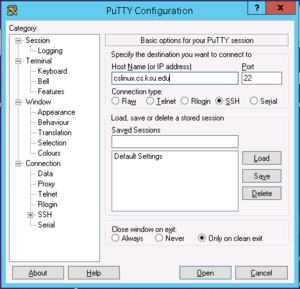Remote Access
Remote Windows Access
The CS Department maintains two servers setup for Remote Desktop access. You may connect to either one of these servers from anywhere on- or off-campus.
If you are connecting from on campus, please be sure to not use the KSU Guest WiFi network. See: KSU Guest WiFi Network
CS Department Users
Anyone with a CS Account (this is separate from your eID account) may login to remote.cs.ksu.edu.
Click here to use a preconfigured RDP File and skip the settings below.
If you wish to manually configure a session, use the settings below. Note: You must prefix your username with the domain name. In this case it would be: WIN2\<eID>. When prompted for a password, you should provide your CS account password, which may or may not be the same as your eID password.
| Login With | Domain | Server | IP |
|---|---|---|---|
| CS account | WIN2 | remote.cs.ksu.edu | 129.130.11.34 |
Non CS Department Users
Other university members without a CS Account may login to the following server using their eID and eID password. (This is the same password used for kSIS and Webmail)
Click here to use a preconfigured RDP File and skip the settings below.
If you wish to manually configure a session, use the settings below. Note: you must prefix your username with the domain name. In this case it would be: USERS\<eID>
| Login With | Domain | Server | IP |
|---|---|---|---|
| eID account | USERS | remote-ksu.cs.ksu.edu | 129.130.11.35 |
Remote Desktop Programs
Microsoft has a remote desktop application that has support on Windows, Mac, iOS, and Android, that can be found in the respective store or Here.
For Linux there are a few Remote Desktop Applications KRDC or Rimmina, both are installed on the CS Systems.
Remote Linux Access
CS users have access to the department's public Linux shell server form anywhere, on- or off-campus.
Connecting from Unix-based machine (Linux, Mac OS X, BSD, Solaris)
To connect from a Unix-based machine, simply open a Terminal window and login using the following command. (Be sure to change <username> to your CS user account name. )
ssh <username>@cslinux.cs.ksu.edu
Connecting from Windows machine
To connect from a computer running Microsoft Windows, you will need to use a secure shell program, such as PuTTY.
Once you have putty downloaded, you will need to specify the server as shown in this screenshot.
Remote Mac Access
Logging In
In order to log into the remote Mac terminal server you will need a Remote Desktop (RDP) Client of some sort, such as Microsoft Remote Desktop.
After opening one of these applications you will just need to enter the the host name, which is remote-mac.cs.ksu.edu and your CS username and password.
Note: If you get kicked out of your session while trying to log in, then just go ahead and try to connect once more. Sometimes this will just let you in.
Accessing Personal User Drive
Here are the Steps on how to access your own personal CIS network drive...
- Open "Finder"
- At the top right of the Mac Desktop the word to the right of the apple should say "Finder", from there select the "Go" button.
- After clicking on the "Go" button you will need to select the "Connect to Server" option. It should be at the bottom of the list.
- In the "Server Address" Text box all you will need to type in is "smb://files.cs.ksu.edu/<your username>"
Firewall Restrictions
KSU Guest WiFi Network
Please Note: For SSH or RDP access to our remote access servers, you must not be connected to the KSU Guest wireless network. This network only allows web traffic on ports 80 & 443 (http/https) and nothing else.
If you are not a guest, please ensure you are connected to KSU Wireless or KSU Housing if you are on-campus.
Access Through Campus VPN
If you need access to any other CS system and don't want to go through one of the above hosts first, you may install the campus VPN client on your remote systems (home desktops, laptops, etc), which you can download here: http://www.ksu.edu/its/security/vpn/. When you run it, you should login with your KSU eID and connect using the "Full Tunnel" option. This routes all your desktop network traffic through the KSU network, effectively putting your desktop behind the campus firewall. You can now use Remote Desktop or SSH client to connect to any CS system.
